Car-to-vehicle communication is attracting attention because it can greatly reduce road traffic accidents, improve mobility, and achieve high-level car automation. Supporting safety-critical applications is at the heart of car-to-vehicle communication. For many years, V2X has chosen the technology to be IEEE802.11p. Recently, under the active promotion of the mobile communication standardization organization 3GPP, a new standard aimed at meeting V2X applications has started. Since the safety of thousands of road users will depend on the performance of these technologies, it is important to compare them.
There are several important related facts that need to be emphasized before comparing IEEE802.11p and LTE-V2X:
• IEEE802.11p is now commercially available, and LTE-V2X is not yet available. There are currently a number of chip vendors on the market that offer IEEE 802.11p-based products. Some Tier 1 suppliers also have complete solutions. In contrast, there are currently no commercially available LTE-V2X products on the market, and it may take many years to see a complete and validated solution. The V2X 5G version that was promised may take longer to surface.
• IEEE802.11p is already installed in many cars on the road. End users can now purchase cars equipped with IEEE 802.11p technology (such as the GM Cadillac 1).
• V2V NPRM has been released. It shows that the US government has a clear intention to fully promote the deployment of IEEE802.11p, and also shows that IEEE802.11p technology can meet the security requirements and pass the test.
• IEEE 802.11p high-volume deployments may start soon. Volkswagen, one of the world's largest automakers, has publicly announced that it will be equipped with IEEE802.11p technology2 in their first cars from 2019.
The cellular world has been advocating that v2x deployments should wait until cellular technology is ready and tested, and completely ignore the investment and field testing efforts to verify the applicability of IEEE 802.11p to safety-critical applications. More specifically, the cellular field claims that LTE-V2X can provide:
• A powerful cellular ecosystem. With years of experience, the system provides paid services and proven technology to the world. Although this is the correct argument, it refers to entertainment services that use cellular technology. The communication between the device and the base station is fundamentally different from the communication between the device and the device in a dynamic environment;
• Double performance [6]. However, as will be pointed out below, in important V2V use cases, the performance of IEEE802.11p completely exceeds LTE-V2X;
• The smallest additional cost. This is problematic because support for safety-critical applications strongly suggests the need to separate these technologies from entertainment hardware and software. Therefore, LTE-V2X is likely to be physically separated from the cellular modem;
• Evolving roadmaps and technologies that will not be outdated in the future, as this technology can be continually improved through a comprehensive testing mechanism for 3GPP conferences. While this may be true, upgrading the standard every 12 to 15 months does not guarantee that the old car will be able to communicate with the new car. This runs counter to the need to create a stable and versatile international standard to drive the success of V2X technology.
This proposed LTE-V2X technology is derived from cellular uplink technology and maintains many similarities with current LTE systems: frame structure, subcarrier spacing, clock accuracy requirements, and resource block concepts. These properties are not very suitable for automotive applications, but are inherited from existing peak technology. Therefore, LTE-V2X is more difficult to meet the special application requirements of vehicle-to-vehicle communication.
Technically, LTE-V2X has problems without network coverage. It has strict synchronization requirements (Section 2.1), otherwise it will not correctly receive messages from adjacent and nearby transmitters (Section 2.3) and the communication distance will be limited (Section 2.4). In addition, the resource allocation mechanism it uses does not correctly handle messages of different lengths (Section 2.5), and the multi-user access mechanism does not handle broadcast messages (Chapter 2.6) or message collisions (Section 2.9). The heavy-duty design of LTE-V2X also leads to higher overhead (Chapters 2.7 and 2.8).
On the commercial side, the LTE-V2X cannot take advantage of the standard LTE modems already available in the car. Different security requirements (Chapter 2.10) and technical requirements (Section 4.1) strongly recommend that the security critical domain of LTE-V2X be separated from the entertainment domain of a standard LTE modem. Strict synchronization requirements (Section 3.2) will also significantly increase the cost of LTE-V2X hardware.
In terms of development strategy, LTE-V2X may not be the best technology for safety-critical applications because its update cycle does not match the car's development cycle (Section 4.1). Although the current version of LTE-V2X has not completed field testing, the 3GPP organization has begun to develop a new version of LTE-V2X. The next generation of IEEE 802.11p is also under consideration (Section 4.2.1), and it is hoped that many of the large-scale field trials will be used to test safety-critical applications.
Our conclusion is that IEEE 802.11p technology is ideal for supporting security-critical applications even without a network. With cellular infrastructure, LTE-V2X is a viable alternative to providing a more mature ecosystem for entertainment services. This win-win situation will focus on the strengths of each technology, work together to provide the best car-to-vehicle communication solution, and continue to deploy IEEE802.11p for safety-critical applications while ensuring new LTE-V2X technology. Can coexist with it.
cutting edgeSince its introduction 10 years ago, V2X has chosen IEEE 802.11p3 technology, which has completed standardization, product implementation and comprehensive testing. Recently, a new standard for V2X applications is being launched under the auspices of the mobile communication standardization organization 3GPP. The security of thousands of road users will depend on the performance of these technologies; therefore, for policy makers, car manufacturers and the wider automotive ecosystem, the first thing to do is to make a comprehensive comparison of these technologies.
1.1 V2X functional goals
It is very attractive to work together and share information to make transportation safer, greener and more interesting. The technology associated with this concept, collectively known as the Collaborative Intelligent Transportation System (C-ITS), promises to reduce traffic congestion, mitigate the impact of traffic on the environment, and significantly reduce the number of fatal traffic accidents.
One of the key technologies supporting C-ITS is wireless communications, covering car-to-vehicle (V2V) communications, car-to-bike (V2M) communications, automotive-to-infrastructure (V2I) communications, and infrastructure-to-vehicle (I2V) communications. These wireless transactions are collectively referred to as cars to everything or V2X communications.
V2X technology will support many C-ITS system applications that are either safety-related and may not be safe. It needs to work reliably in very dynamic environments, has a relatively high communication speed between the transmitter and receiver, and supports extremely low latency in safety-related applications such as highways, crowded city intersections, and tunnels. Time.
1.2 IEEE802.11p
The IEEE 802.11p design meets every V2X application requirement and the most stringent performance specifications. In 1999, the US Federal Communications Commission (FCC) set aside 75 MHz of spectrum in the 5.9 GHz zone for V2X. The IEEE 802.11p standard therefore works within this frequency range.
IEEE 802.11p is an extension of IEEE 802.11a (WiFi) that operates in a self-organizing network mode and does not require BSS (Basic Service Set, WiFi 'Base Station'). It is optimized for the movement conditions of obstacles and can handle fast-changing multipath reflections and Doppler shifts due to relative speeds up to 500 km/h. The typical line of sight (LoS) communication distance is 1km, but the main goal of IEEE802.11p is 'can see the corner' (non-line of sight, NLOS), because no other sensor in the car can do this. The facts show that with the world's most advanced technology, the current commercialized spot products usually reach a larger range of several kilometers. When the IEEE 802.11p multiple access mechanism (Clash-Aided Carrier Sense Multiple Access Protocol, CSMA-CA protocol) is used in conjunction with Distributed Congestion Control (DCC), it can efficiently cope with high-density applications.
Standardization began more than 10 years ago, and the final draft was approved in 2009, and a lot of testing and verification work has been done since approval. The simTD project [8] was the first large-scale field test project that began in 2009 with more than 100 vehicles. Since then, there have been dozens of field trial projects for commercializing IEEE802.11p products, and many others are still in progress. Some of these items are mentioned in Ref. [8-13]. One of the largest IEEE802.11p pilot projects funded by USDOT (Wyoming, Tampa and New York City), contains more than 10,000 vehicles that have achieved a variety of applications, with a total investment of more than $45 million [13]. A huge investment is used to ensure the quality and reliability of this technology.
A number of semiconductor companies have designed and tested IEEE 802.11p compatible products that are qualified for automotive certification. A wide range of hardware and software products are available from multiple vendors to form a rich ecosystem. There are many models on the market that use IEEE802.11p technology, and other models are being released soon, such as:
• The universal Cadillac CTS car is equipped with IEEE802.11p4;
• Toyota has nearly 100,000 vehicles equipped with IEEE802.11p in Japan;
• Volkswagen chose IEEE 802.11p technology to support V2X applications5.
The USDOT announced that based on the evidence gathered, IEEE 802.11p technology can significantly reduce the number of collisions on the road. Experts expect the USDOT to enter a formal process that will force the adoption of IEEE 802.11p technology [14] for all new portable vehicles for safety reasons.
1.3 LTE-V2X
LTE-V2X is a relatively new technology (first discussed in 2015) and is an extension of 3GPP Rel-12 device-to-device (D2D) functionality, which itself relies on the use of LTE uplink transmissions and uplink spectrum resources. Direct communication between devices is achieved. The V2V basic security function first appeared in the LTE Rel-14 specification.
The LTE-V2X was designed with multiple deployment scenarios in mind, so the following requirements were made:
1. Ability to work with or without eNB ('base station') coverage. The LTE-V2X in Rel-14 is based on the PC5 interface, allowing users to broadcast messages directly to each other with or without network coverage. Operation under cellular coverage can take advantage of all the benefits of a synchronous network where central coordination, scheduling, and management are implemented using a range of base stations. It should be noted, however, that there are many scenarios in which such devices do not work, such as rural areas with poor coverage, highways, and fast-moving users who frequently switch base stations. LTE-V2X technology must be able to achieve reliable operation in areas without base station coverage;
2. Work independently under dedicated, unlicensed carrier or licensed spectrum conditions;
3. Enhance the D2D air interface function to support low latency, high density and high speed.
In order to meet the increased requirements, Rel-14 LTE-V2X introduces a new Sidelink transmission mode (transmission mode 3 & 4), refer to Table 1. Due to the introduction of low-latency transmission techniques, these modes differ from the Rel-12 D2D mode (Transmission Mode 1 & 2), which improves support for higher speeds and new distributed channel access mechanisms.

Table 1: Operating modes available in LTE-Sidelink communications.
Although the industry has made great contributions and standardization work in recent years, the LTE-V2X standard is still far from mature, and many technical topics are still under discussion. During the recent RAN meeting, everyone also agreed to make a number of significant standard changes. The large number of maintenance modification requests (CR's) associated with V2X has made chip manufacturers face significant challenges in determining feature sets, entering interoperability testing phases, fixed hardware and software architectures, and commissioning. Automakers also question their actual performance and support for safety-critical use cases. At this point, the actual performance of the LTE Rel-14 standard is almost unknown.
The most relevant and challenging LTE-V2X operating mode for safety critical applications is Sidelink Transmission Mode 4, which can be viewed as an ad hoc mode. The focus of comparison with IEEE802.11p technology is on this model.
2. Comparison of LTE-V2V Mode 4 and IEEE 802.11pBoth IEEE 802.11p and LTE-V2X employ well-known orthogonal frequency division multiplexing (OFDM) modulation techniques in which data blocks are arranged for transmission with equidistant subcarriers. however,

As shown in Table 2, they chose very different parameters. LTE-V2X inherits many LTE mechanisms and is suitable for centralized (ie, non-self-organizing) and synchronous networks with power control and synchronization adjustment functions, and works at low to medium speeds. As discussed later in the chapter, it is not well suited for ad hoc network communication modes and cannot be used in many important V2X applications.
2.1 Synchronization
Compared to IEEE802.11p, LTE-V2X is more sensitive to frequency error and timing error. In the case of inaccurate frequency synchronization, residual frequency errors can cause carrier beat interference (ICI). In LTE-V2X, the subcarrier spacing of OFDM is nearly 10 times higher than the subcarrier spacing of IEEE802.11p, so the same absolute frequency error has a much greater impact in LTE-V2X than in IEEE802.11p. This will result in limited LTE-V2X performance, and the same absolute frequency error will produce 100 times more interference power. Table 3 quantifies the timing accuracy and frequency accuracy requirements for IEEE 802.11p and LTE-V2X.

* Timing accuracy is specified in the IEEE 1609.4 standard for channel switching
The operation of IEEE802.11p has no dependence on timing; frequency accuracy is specified in IEEE802.11.
** Timing accuracy is specified in 3GPP TS 36.133; frequency accuracy is specified in 3GPP TS 36.101
There are two obvious major differences:
1. LTE-V2X requirements are much stricter;
2. The requirements of LTE-V2X are related to the synchronization source of the user. When users use different synchronization sources, such as locking to different base stations, the synchronization requirements will not be met, thus affecting the communication performance between the cars.
To meet these synchronization requirements, LTE-V2X users need to rely on Global Navigation Satellite System (GNSS) signals. However, this brings other challenges. For example, in fact GNSS signals may be lost or not reliable enough in locations such as tunnels, underground parking lots, and urban canyons. In the absence of GNSS coverage, synchronization within the required accuracy range depends on the user's local oscillator drift. The higher the accuracy, the higher the cost, as required by strict subcarrier spacing. In the absence of a reliable GNSS signal or no GNSS signal at all, the user has to choose an alternative source to achieve synchronization, which affects the reliability of the communication.
IEEE 802.11p does not need to rely on GNSS signals when working. IEEE 1609.4 also requires GNSS signals, but is only used to switch from one channel to another, which means much lower timing and frequency accuracy.
2.2 high speed conditions
The Doppler shift occurs when a moving car transmits a signal. This frequency shift can be seen as an additional frequency error (in addition to the synchronization error). At high speeds, these Doppler shifts may be twice or even four times the synchronization error (increasing as the relative speed of the car increases) and become a major part.
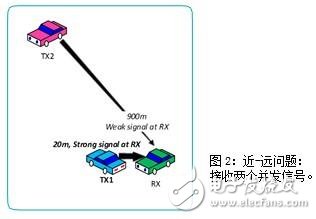
As shown in Figure 1, the symbol period in LTE-V2X is 10 times longer than IEEE802.11p, which limits the maximum detectable Doppler shift and therefore limits the maximum speed (except for tracking fast changes). Outside the channel). In fact, this drawback has been observed in the 3GPP simulation results, that is, when the speed exceeds 140 km/h, the message can no longer be reliably detected and the performance is poor. The 3GPP solution to this problem is to introduce complex processing methods, but this method has proven to be not powerful enough; or to reduce the modulation and coding scheme (MCS), but it does not solve the problem. It is recommended that modifying the pilot symbol pattern or shortening the symbol period is not acceptable, so the final LTE-V2X is strictly limited to applications with speeds below 140 km/h.
While IEEE 802.11p benefits from a very short symbol period and a selected symbol pilot pattern, there is no limit to the performance at high speeds. Although LTE-V2X is limited to work below 140km/h, IEEE802.11p performance is remarkable at speeds of 250km/h or higher.
2.3 Near-end problem
LTE-V2X is very sensitive to users receiving signals from two or more transmitters with different power levels, ie near-far problems, as shown in Figure 2. This power difference can occur when one of two adjacent transmitters is blocked. IEEE 802.11p allows a single user message to be transmitted per OFDM symbol, and the receiver can individually set its parameters in an optimal manner for each user, such as automatic gain controller (AGC), time offset estimation, and frequency offset estimation. Because the symbols are not shared.
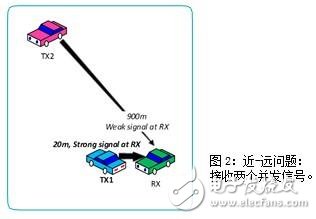
LTE-V2X allows users to share resources within the same OFDM symbol (Figure 3), but the receiver only sets the gain value of its automatic gain controller based on a single combined signal. Therefore, the ability of an LTE-V2X receiver to receive a weak signal in the presence of a strong signal is limited to 6. But weak signals may be more important than strong ones. For example, a strong signal may come from a transmitter behind a vehicle that is less associated with a security decision, while a weak signal may come from an approaching transmitter that may pose a real risk.
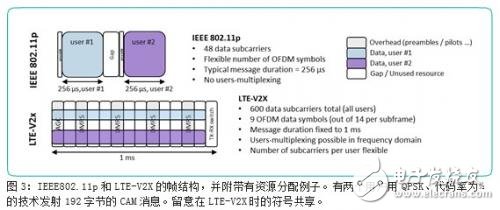
In order to solve the near-far problem, LTE-V2X introduces the concept of earth partitioning, which includes establishing spatial isolation according to the absolute geographical location of the user. Users in different locations can only be limited to selecting resources for transmission from a specific time-frequency set. This solution is of course very interesting, but requires field validation to assess the uneven distribution of users and the impact of their fast moving position.
2.4 Maximum communication distance
One way to compare V2X technology is to compare the actual performance of the test under the same conditions outdoors. IEEE 802.11p has been proven to achieve large communication distances in various field trials, and has been able to reach several kilometers in the case of highways. Unfortunately, there are no results available for comparison in the LTE-V2X field trial. However, the LTE-V2X synchronization concept has a limitation on the communication distance between users, which is reflected in the different roles assigned to the cyclic prefix (CP), as shown in Table 4.

In a synchronous system such as LTE-V2X, all users' signals must arrive at the receiver synchronously in time to prevent inter-symbol interference between consecutive OFDM symbols. This requirement is unsatisfactory in practical applications because either the signal propagation times from different transmitters are not equal, or the timing references used by each user for their own transmission are not equal. This is an example when the user is in coverage and the eNB is used as their timing reference (when GNSS is not available). In this case, each user's transmission time is based on its own downlink timing reference 7. Naturally, some users rely on the eNB (with shorter propagation delays), and some users are farther away. Near-users begin transmissions earlier than distant users, while nearby (RX) users of nearby users also set corresponding receiving windows. The far user's transmission will arrive at the receiver after the round trip propagation delay. In the case where the remote transmitter is too far away, it may arrive too late and exceed the receiving window, causing the receiving side to be unable to detect the message, see Figure 4.
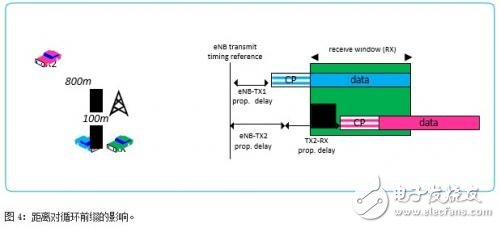
As can be seen from the figure, there is a limit to the communication distance beyond which the receiver will not be able to detect messages sent by remote users. Table 5 lists the maximum distances that LTE-V2X can achieve. In some cases, the NPRM requirements of the Do-No-Pass-Warning message defined in the message cannot be met.

2.5 Resource allocation
The actual V2X service pattern is characterized by packets of variable size. Message groups such as CAM (specified by ETSI) and basic security messages (BSM, specified by SAE) are generated periodically (usually every 100 ms), including vehicle status information such as geographic location, speed, orientation, and other related information. The car occasionally attaches a set of path predictions and/or recent path history points to these messages. The number of points depends on the road condition, but in the case where each point is described by about 10 bytes, this added information can easily occupy an extra 10 bytes in the load. Another example of changing the length of a message is security-related: For BSM, the entire security certificate is sent every 500ms, and the default message length is increased by another 100 bytes. The IEEE 802.11p resource allocation scheme can easily support variable packet sizes. Once a user occupies the channel, it will use its resolution of one OFDM symbol (ie, 8 microseconds) to determine the transmission duration so that the load transmission time becomes shorter/longer. In LTE-V2X, users reserve resources in a semi-permanent manner, that is, before they know the exact packet size. Retaining resources in advance before the application layer's load size has not been determined can result in over-allocation (no efficiency) or under-allocation of resource sizes (requiring more dense coding and reducing the probability of detecting messages). In any case, a simple resource allocation mechanism suitable for IEEE 802.11p is more efficient when dealing with variable load sizes.
2.6 half duplex
As is apparent from FIG. 3, two users under LTE can transmit messages in the same OFDM symbol using different frequency resources. At a given moment, users either send or receive because their wireless system is operating in half-duplex mode. In this way, the two users will not receive each other's messages even if they are close together, thus missing the information necessary for safety-critical decisions. They have to wait until one or two of them select a new resource for the transfer.
2.7 Physical layer efficiency
Overloaded LTE waveforms and frame formats will be converted to higher overhead under a single user, as shown in the table below.
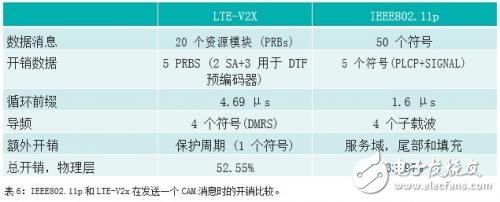
2.8 capacity
V2X is suitable for high traffic density applications. Capacity is defined as the ability of all vehicles in a certain area to communicate without competing for the same resources, as competition will eventually lead to shortened communication distances and increased delays. IEEE802.11p and LTE-V2X have similar capacity and distance under equivalent conditions.
Table 7 shows that the capacities of LTE-V2X and IEEE 802.11p are basically the same, and a given 10 MHz channel can accommodate about 2 messages in 1 ms.
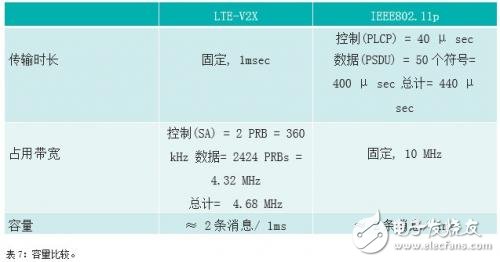
2.9 Message conflict
There will be multiple users in a given section of a road, and each user will send messages at regular intervals. IEEE 802.11p solves the potential conflict problem by implementing the CSMA-CA protocol, which checks if the wireless channel is in use before starting a new transmission. LTE-V2X does not have an equivalent mechanism and will not be detected if a collision occurs. Two users may send messages using the same resource block. The resource is kept for multiple transfers by semi-permanent allocation techniques before the resource is reselected. Therefore, multiple transmissions of these two users will be lost.
LTE-V2X mitigates this problem by adding a certain degree of randomness to reselect event time between users, but does not completely resolve the risk of conflict.
For example, both cars are approaching an intersection. Once in the effective communication range, IEEE802.11p will ensure collision-free operation and will issue a warning if necessary. LTE-V2X can't do this, so it loses precious time.
2.10 Network Security Protection
The functional safety certification defined in ISO 26262 for on-road vehicles proposes verification and validation measures to ensure adequate and acceptable levels of safety. Risk and hazard analysis determines the level of automotive safety integrity (ASIL) by measuring the potential for life-threatening. Since V2X may control the car, such as in fleet applications, it can be assumed that V2X requires ISO26262 for ASIL B rating. Additional costs are required to achieve ASIL B ratings, so it is highly recommended to separate non-security critical domains and security critical domains in terms of software and hardware. If the non-secure part of the system is not isolated, then it will also be ISO26262 certified, which will become particularly difficult and costly. In addition, domain isolation helps to make stronger and better protection against potential network attacks, as shown in Figure 5. The isolation of hardware and software clearly shows that it is not possible to cover the LTE-V2X application space by simply reusing standard LTE modems.
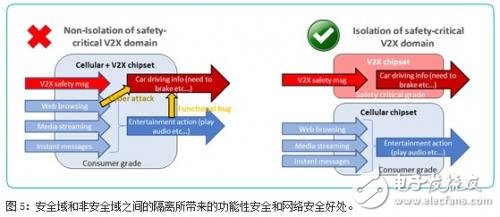
The highly complex LTE-V2X solution means higher cost than the IEEE 802.11p solution. Therefore, it will become more expensive to satisfy security applications with LTE-V2X.
3 cost factors3.1 Unable to reuse standard LTE modem
The standard LTE modem chip stage only decodes a single transmission for each transmission time interval received from the base station. In LTE-V2X, in addition to decoding base station data, the chipset also requires decoding multiple transmissions (from different users) concurrently for each transmission time interval, thus requiring a larger amount of hardware. Standard LTE modems cannot be reused because the waveforms and signal formats in the LTE-V2X are different from standard LTE.
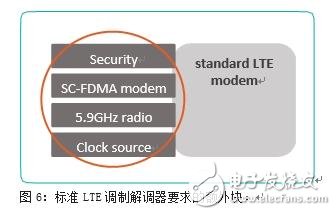
Also add a 5.9GHz wireless chain and a stable GNSS synchronous clock source, see Section 2.1.
From a cost perspective, the LTE-V2X and IEEE 802.11p systems differ only in terms of modem and clock source, while higher layers, human-machine interfaces, and security use cases are all the same. In fact, IEEE 802.11p modems are no more expensive than adding LTE-V2X to the side of the cellular chipset because of the large impact of LTE-V2X clock sources and authentication costs (the impact of AEC-Q100 on cellular chip-level costs) . Therefore, even without domain isolation, LTE-V2X is not cheaper than IEEE802.11p.
3.2 Timing and Clock Accuracy
The extra sensitivity of LTE-V2X to precise synchronization means an impractical reference clock, see Table 3, because the accuracy of the clock source is related to performance and robustness. The demanding temperature drift and high frequency stability of the clock components under high temperature and high stress will eventually lead to cost increases.
For IEEE802.11p, the accuracy requirements are almost the same as those of commonly used WLAN devices, so the synchronization accuracy requirements do not affect the cost of the IEEE 802.11p system.
Even if the GNSS coverage signal is temporarily weak, the LTE-V2X should be able to maintain the same level of accuracy for a long time. When LTE-V2X cannot rely on GNSS and cannot find another user synchronized with GNSS (indirect or direct), the LTE-V2X system must still generate and transmit V2X messages with a specified frequency of 0.1 ppm. It is unrealistic for a car to meet this accuracy requirement because the associated components can be very expensive. This level of accuracy is reserved only today for macro base stations (macro eNBs) that integrate high-end oscillators, but this type of oscillator is never used for consumer terminals, nor can it withstand large temperature changes and is susceptible to vehicle vibration. And the impact of acceleration.
3.3 Motorcycles/Electric Bicycles: There are no cellular modem barriers for these most vulnerable road users
The cost of LTE-V2X without a standard LTE modem is even higher, significantly higher than IEEE802.11p. Cellular modems are not common in motorcycles and electric bikes because eCall regulations do not apply to motorcycles. Therefore, the impact of LTE-V2X cost on relatively low-cost motorcycles is an obstacle.
Due to the high mobility of motorcycles, the positioning of motorcycles is a big challenge. GNSS and V2X antennas must be placed with care and should not be affected by the unknown location, orientation and shielding of the smartphone. So using a smartphone to support V2X applications is not a suitable method. IEEE 802.11p is the most economical active safety solution for motorcyclists who need V2X protection.
4 Maturity and future prospects4.1 sampling car cycle
The pace of development in the automotive market is very different from that in the cellular market. A mobile phone is usually replaced in three years, and a car may take 15 to 30 years and requires reliable work within this time span. Therefore the technology must be mature and fully validated. A recall in the event of a failure has serious consequences because the impact of recalling a car and recalling a smartphone is different.
For this reason, a wide range of quality measures have been proposed for automotive components in terms of reliability, longevity and working conditions to ensure a low elimination rate (generally less than 1 ppm). These measures cover not only the design cycle, but also testing and certification.
Since V2X is essential in (semi)automated driving, we hope that it can be used at least in systems with ASIL-B or higher safety ratings, and with AEC-Q100 (stress-based stress test certification) IEC62132 (EMC immunity) and ISO26262 (functional safety certification) are on an equal footing. Network security is another important aspect of security technology. The entire system should be secure and there should be two submodules (HSM and Gateway) that should be certified. Investments in time and equipment will exceed the normal range of investment in cellular consumer products. The design approach is different: is the cellular mobile communications industry willing to make such investments?
4.2 Future development and backward compatibility issues
4.2.1 LTE-V2X
While summarizing Rel-14 LTE-V2X ("Phase 1") 8 , 3GPP is already studying the future enhancements of LTE-V2X Rel-15 ("Phase 2"), which is expected to be part of the December 2018 specification. release. The main goal of Rel-15 Enhanced Coverage is 9:
• Carrier aggregation (up to 8 PC5 carriers)
• 64-QAM technology
• Study the benefits and feasibility of shortening the transmission time interval (1 ms)
• Study the benefits and feasibility of transmit diversity
These goals are not intended to address the fundamental challenges presented in this paper.
One of the main problems in introducing new enhancements in Rel-15 is the handling of backward and forward compatibility of V2X messages. If the 3GPP specification does not meet this requirement, there is no enthusiasm for launching the Rel-14 V2X, because everyone knows that Rel-14 is a technology that comes to an end. However, this requirement is still far from being met, as the Rel-15 technical specification is not yet ready.
4.2.2 IEEE802.11p
The IEEE organization is continuing to develop and improve the 802.11 "WiFi" wireless LAN family of standards. All WiFi series specifications ("a", "ac", "n", "p" wait) are collected in one document. Such a document is the official IEEE 802.11 standard, and the latest version was released in 2016.

We can see that IEEE is about 8 years ahead of 3GPP in terms of V2X targeting applications. The first version ("802.11p") has been extensively tested since 2010 and is now a very secure, mature and reliable technology for V2X.
Based on extensive experience, people continue to improve the 802.11p standard. The new version is currently named "802.11px". Improvements include the use of the latest 802.11 "n" and "ac" technologies, such as low density parity check (LDPC) for channel coding, MIMO/antenna diversity, and improved OFDM pilot layout.
To take advantage of all the development and field trials of the past decade, 802.11p users are likely to be backward compatible with 802.11px because it is compatible with other 802.11 family standards. It seems that 802.11px will naturally be a subset of the 802.11p standard. This will ensure a smooth transition between the two technologies, while still maintaining the power of the 802.11p standard after the introduction of 802.11px.
4.3 Review of the promotion process of cellular technology
From the past process of cellular technology in the past, it takes five to six years from the release of the first technical report specification to the actual batch deployment in terms of the timetable associated with the launch of the new cellular technology. For example, LTE took 5 to 6 years from the release of the first version of the specification (released in version 8.0 in October 2007) to reach more than 100 million users (end of 2012).
We remember that until now (June 2017), the Rel-14 V2X specification has not been completely fixed, and technical corrections are still being made, so it is very doubtful when the LTE-based V2X can be considered mature and can be widely used. Adopted and can be deployed in large quantities, which may take many years to finalize.
The LTE-V2X is still changing. This article is only based on the content that has been released so far, and some of the issues involved may find a solution in the future, but these assumptions based on future scenarios also mean that the landing of LTE-V2X technology needs to be postponed.
For LTE-V2X based on LTE technology, the future will be seriously threatened by the newly released 5G new wireless technology (NR). Today, 3GPP is advancing the first release of 5G NR as soon as possible. 5G will propose another solution for V2X (V2X Phase 3, or eV2X), but this solution can only be implemented in the second edition of 5G NR. Therefore, the automotive industry may not be willing to adopt a technology (LTE Rel-14) that we already know will soon be eliminated by 5G.
4.4 Mixed solution
A hybrid approach can combine the advantages of each technology to produce a more complete and promising solution. For example, IEEE 802.11p is stronger than LTE-V2X in terms of security messages. On the other hand, cellular networks can provide longer distance connections between vehicles and between vehicles and the cloud.
There is currently no standardization activity that defines the interconnection of IEEE 802.11p and cellular.在3GPPä¸å¢žåŠ 这项工作有助于引入åŒæ–¹çš„最强项,æ高蜂çªè¿žæŽ¥å‘汽车ä¸çš„渗é€çŽ‡ã€‚
5GAA建议将独立的10MHzä¿¡é“分é…给这两ç§æŠ€æœ¯ã€‚然而,LTE-V2Xå‘射机会使IEEE802.11p接收机致盲,å之亦然。
å¦å¤–,5GAA建议(在申请使用5.9GHzçš„ITS专用频段的申请书ä¸æ到)将产生å±é™©çš„å…ˆä¾‹ï¼Œå› ä¸ºå…¶å®ƒæ–°æŠ€æœ¯å¯èƒ½åˆ©ç”¨è¿™ç§ç†ç”±ç”³è¯·é¢‘段资æºè€Œä¸è€ƒè™‘对现有安全关键网络所带æ¥çš„æ ‡å‡†ç¢Žç‰‡åŒ–è´Ÿé¢å½±å“。
两ç§æŠ€æœ¯åº”该以积æžä¸»åŠ¨çš„æ–¹å¼å…±å˜ï¼Œæ¯”如通过定义一ç§é€šç”¨çš„æ–¹å¼è®¿é—®å¯ç”¨èµ„æºã€‚由于IEEE802.11på·²ç»åœ¨å¸‚场ä¸å¾—åˆ°éƒ¨ç½²ï¼Œå› æ¤LTE-V2Xå¯ä»¥ç®€å•åœ°éƒ¨ç½²ä¸ŽIEEE802.11p相åŒçš„MAC,å³åŸºäºŽCSMA-CAå议的MAC。
5 本文å°ç»“ç›®å‰æŽ¨èçš„LTE-V2X是蜂çªæŠ€æœ¯æ»¡è¶³å®‰å…¨å…³é”®è¦æ±‚çš„é‡è¦ä¸€æ¥ï¼Œä½†å®ƒè¿˜æ²¡æœ‰è¾¾åˆ°IEEE802.11p的性能ç‰çº§ï¼ŒIEEE802.11p在未æ¥å¤šå¹´ä»å°†æ˜¯ä½œä¸ºåœ¨é“路上挽救生命的关键通信技术的唯一选择。
对适用于V2X应用的IEEE802.11på’ŒLTE-V2X的详细技术性观察进一æ¥ç¡®è®¤äº†å®ƒä»¬çš„互补特性。
在有网络的情况下,LTE-V2Xå¯ä»¥åˆ©ç”¨èœ‚çªé¢†åŸŸä¸å¤šå¹´çš„创新æˆæžœä¸ºV2Iå’ŒI2VæœåŠ¡æ供有效的替代方案。IEEE802.11p也覆盖V2Iå’ŒI2V,但效率较低些。
在没有网络的情况下,由于需è¦ä¿æŒä¸ŽLTEä¸ç›¸åŒçš„符å·ç»“构和相似的帧结构,LTE-V2X会有很大的问题。IEEE802.11p在é²æ£’性和效率方é¢è¡¨çŽ°æ›´å¥½ã€‚
安全关键和挽救生命的应用ä»ç„¶æ˜¯æ±½è½¦åˆ°æ±½è½¦é€šä¿¡çš„æ ¸å¿ƒéƒ¨åˆ†ï¼Œå› æ¤å®ƒå¿…须能够在缺少网络的情况下有效的工作。
LED power supply, CCTV center power supply device, LCD display power supply.
We can meet your specific requirement of the products, like label design. The plug type is US/UK/AU/EU. The material of this product is PC+ABS. All condition of our product is 100% brand new. OEM and ODM are available in our company, and you deserve the best service. You can send more details of this product, so that we can offer best service to you!
Power Supply,5V Power Supply,12V Power Supply, 24V Power Supply
Shenzhen Waweis Technology Co., Ltd. , https://www.laptopsasdapter.com
